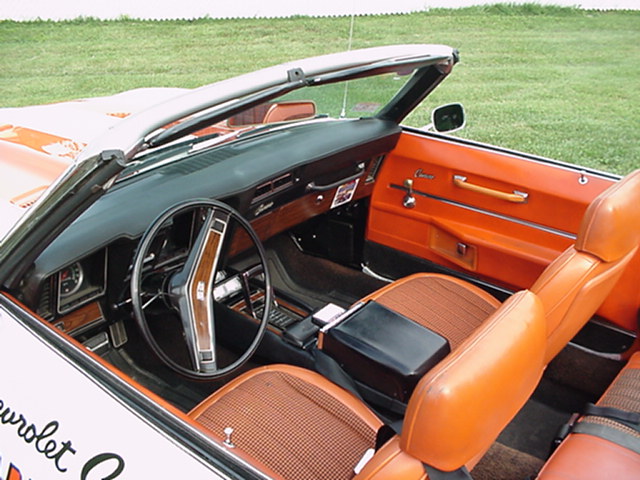CRG Research Report
69 Pace Cars and Z10's
© 2007-2025,
Camaro Research Group
Author -
Reviewed by the CRG
Last Edit: 07-Mar-2025
Previous Edits: 10-Feb-2020, 25-Jul-2019, 29-Feb-2016, 10-Aug-2009,
17-Mar-2009, 27-Feb-2007, 30-Jan-2007, 15-Jan-2007
Original Release: 11-Jan-2007
|
Index
Introduction
The 1969 Camaro was chosen as the
Official Pace Car for the 1969 running of the Indianapolis 500 and as the
Official Car of the ‘500’ Festival. This was a repeat
performance for Camaro since it had also been chosen as the 1967 Pace Car.
To help them stand out on the large expanse of track, the 1969 pace
cars were designed to be visible: Dover White RS/SS convertibles with
Hugger Orange Z28 style stripes and orange houndstooth cloth seats. All were
equipped with the recently released fresh air hood (aka: cowl hood).
Indy Festival and Courtesy Cars
The pace car was announced to the media at a February press conference
in Indianapolis, aided by a display vehicle
that showed off the pace car colors.
[1]
Chevrolet supported the race by providing the actual pace
car, a backup pace car, a pace car replica (with air conditioning, power
top, and show car finish) to be presented to the winner of the race, and
a fleet of courtesy and support vehicles. This fleet included an
additional 130 pace car replicas, 16 Impala station wagons,
18 pickups, two Suburbans, and one van.
The 1969 Pace Cars, and most of the support vehicle fleet, at Indy
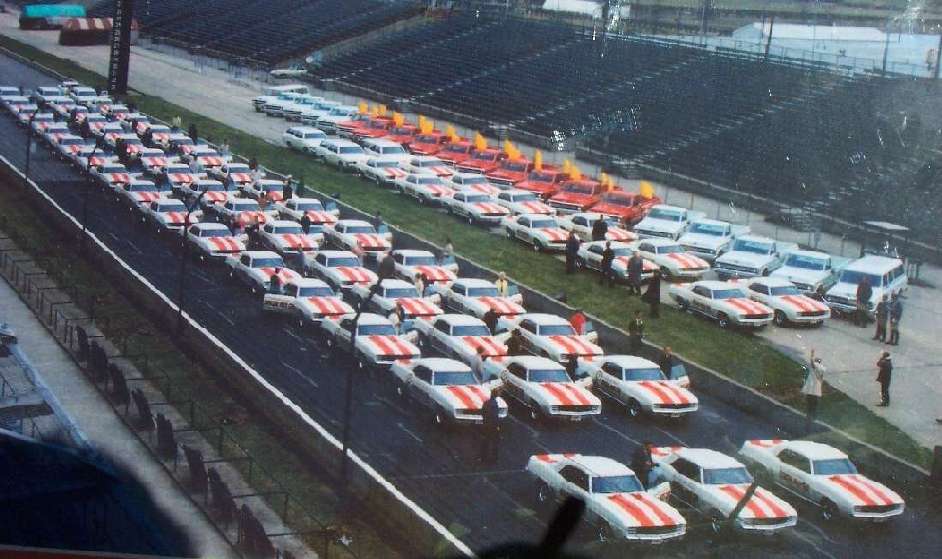 |
Indianapolis 500 Festival Decal
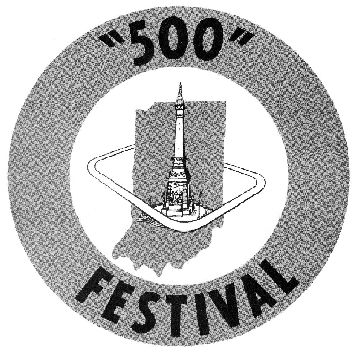
|
Forty-three pace car replicas, all SS350 automatics, were
provided to the “500” Festival Committee for use in
the Festival Parade and other events. One of these cars
(#34, 9N609349) and a matched set of luggage were then presented
to the Festival Queen. In the picture above, the two pacers and
the winner's car are believed to be in the front row and the
Festival cars (identified by the Festival sticker
on the rear quarter panel) are lined up behind them.
Seven replicas were provided for use by Speedway
officials, and five replicas were for USAC officials. The remaining 75
replicas were for the visiting press and VIP's. Most of these
cars were 350 automatics but some had 396 engines and 4-speed
manual transmissions. It is believed that all the pace cars at
the track were built in February, 1969, and all were built at the
Norwood plant. The VIN's of some of the pace cars
that were at Indy were recorded by Dr. John Mansell
who attended the race. His list of
55 pace car VIN's was published in the United States
Camaro Club magazine in 1992. The highest VIN he recorded was 9N610726.
Only the cars at the race had the door decals installed. The local Indy dealers who prepped
the cars would have done the installation. There is no part number for the decals which means they
were not in the GM parts system - probably either the zone or the advertising agency procured them.
Original owners of pacers also confirm that decals were neither included or offered. There have been
several reproductions of the door decals over the years.
The Real Pace Cars
The two cars built to actually pace the race, the
pace car and the backup car, were both ordered with the L89 aluminum
head 375 hp 396 engines, automatic transmissions, power steering,
sport-styled steering wheels, consoles, gauges, and AM radios.
After assembly, they were shipped from the Norwood plant to the GM Tech Center.
Both cars were then identically prepared by Chevrolet
Engineering and Chevrolet Experimental Department. The engines and
transmissions were disassembled, thoroughly inspected, and reassembled.
The aluminum heads were replaced with L78 cast iron heads,
a special 6-bolt COPO torque converter was installed, and
service JL8 four-wheel disc brake axles with 3.31 gears were installed.
(The cars were not ordered with JL8, possibly due to limited JL8 availability.)
The driveshaft was balanced and the front JL8 brake
components were installed. All chassis safety items and suspension
components were magnafluxed/inspected and treated to insure
they would not fail at the race. The heavy-duty battery and a
61-amp alternator were used to ensure 12
volts at all times (it is unclear whether the cars were ordered with
these items or retrofitted). Prestretched drive belts were used and
‘aircraft-type’ hose clamps were installed on all hoses.
15-inch rally wheels replaced the standard 14-inch wheels.
One car was equipped with Firestone tires and the other with
Goodyear tires to give both companies equal promotional time.
Several external and internal body modifications were made
for the pace car duties. Grab handles for the passengers were installed
and flag brackets were mounted on the rear bumper. A two-way radio was
installed to communicate with the tower. Hood pins and special
convertible top boot fasteners were used to keep things in place
at the 130 mph pace speeds.
The pace cars were driven by Jim Rathmann, winner of the
1960 Indy 500. Both pace cars were used to pace the race. The #1 car was
used for the initial pace lap. The #2 car was used when the pace lap was
rerun due to an accident. Both cars still survive.
The Pace Car Replicas
February 4, 1969 Product Bulletin
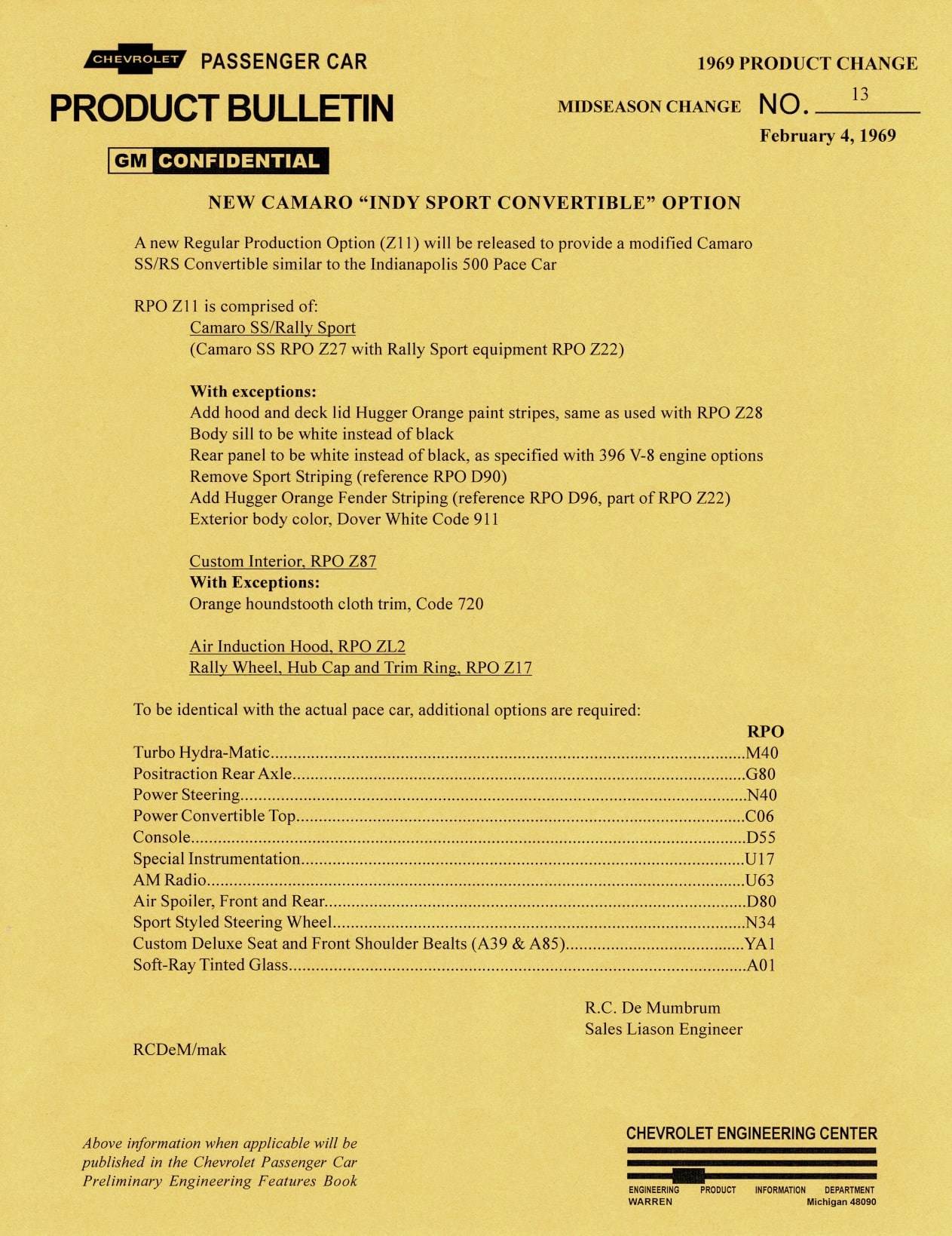
|
|
1969 Camaro Pace Car advertisement
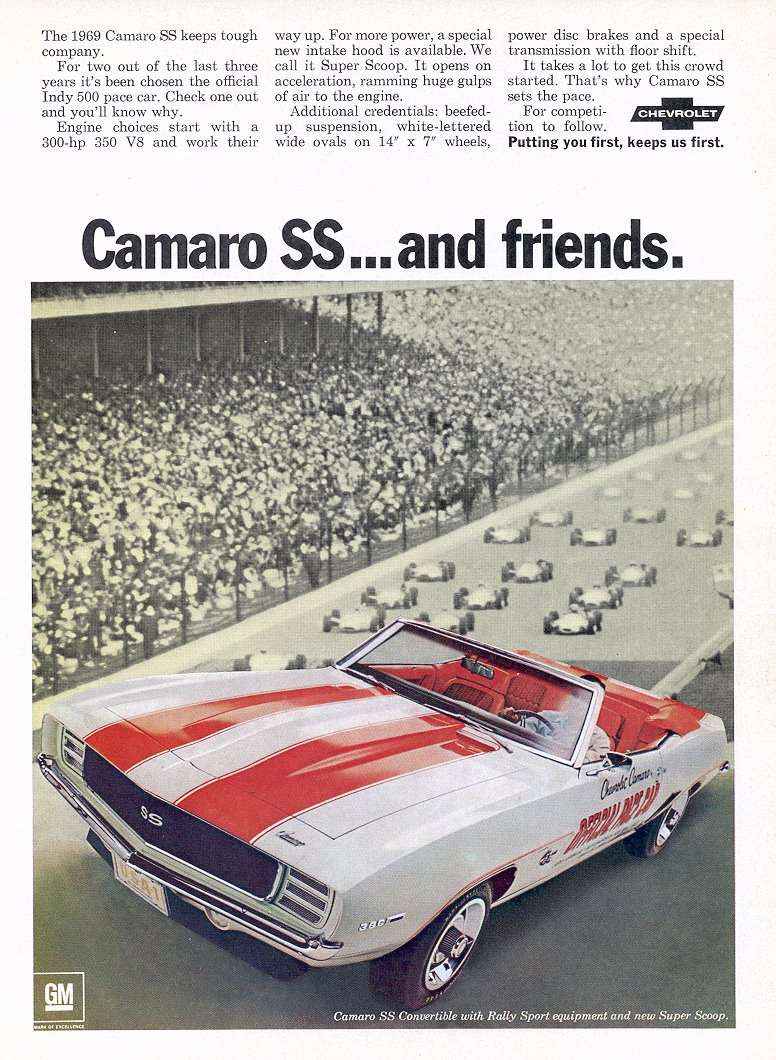
|
|
Replicas of the pace cars were also white RS/SS convertibles with
white tops ordered under RPO Z11. The Z11 option was announced in the
February 4, 1969 Product Bulletin.
Chevrolet also stated that “...we plan to build replicas of the
Pace Car to be sent to nearly all of the 6400 Chevrolet dealers
across the country”. Actual production was 3,675 cars; this number
includes the Camaros that were provided as courtesy and track
vehicles at the race.
The Z11 option was listed on the window sticker as 'Indy 500 Pace Car Accents'
for $36.90. The SS side stripes were replaced with the orange Z28 hood
and deck lid stripes. (The pace cars and the Z10's were the
only non-Z28 models to use those stripes.) The Z11 package added orange
D96 fender striping (not normally painted on Z28's), and also added
white rocker panels (normally blacked-out on SS cars), and white rear tailpanels on
the SS396 cars (normally blacked-out on big-block tailpanels).
The required options with the Z11 package included C05 white convertible
top, D80 spoilers, YA1 deluxe seatbelts,
ZJ7 rally wheels, ZL2 special ducted hood, Z22 Rally Sport,
Z27 Super Sport, and Z87 custom interior (orange houndstooth, code 720).
Cloth seats were not otherwise available in a convertible.
The base drivetrain was the SS350 with a 3-speed manual transmission.
Any other option could be added, including 396 engines and
optional transmissions. Most cars were ordered with an optional
transmission, most commonly a 4-speed manual or a 3-speed automatic
(though both 3-speed manual and 2-speed automatic pace cars do
exist).
Note that console and gauges were optional, thus
automatic cars can be column shift. Deluxe front
shoulder seatbelts (RPO YA3) were not required, but are a somewhat
common option on pace cars. Over 40% of the pace cars exported to Canada had the
YA3 option
[2],
though only 922 convertibles had them in 69.
Power convertible top is another common pace car option. No
documented pace car has been found with JL8 four wheel disc brakes,
though a few have had the JL8 brakes added by owners.
There is no documentation of the number of big block pace cars that
were produced. The author estimates the percentage of 396 pace cars to be
between 20-25%, or approximately 735 to 920 cars. Several sources were
used for this estimate. CRG's database (though not a random sampling)
contains data on over 20% of the 69 pace cars and about 25% of these
cars are 396 cars. Furthermore, 20% of the pacers exported to Canada
were big blocks.
[2]
For reference, 38% of all 69 SS Camaros were equipped with 396 engines.
Pace cars were a bold color combination and were expensive -- at least $3700
for the basic 3-speed manual car. Most pace cars were ordered with more options,
such as an optional transmission for ~$200, power steering for $95, etc.) yielding
$4000+ cars. The cost and the colors resulted in some cars sitting
on dealer's lots for months; several sat for a year or more! On the other hand,
some cars were purchased the day they showed up at the dealer.
ID'ing
The 3,675 pace car replicas were built at both Norwood, OH, and Los Angeles,
CA assembly plants. Analysis of the CRG database indicates that approximately
3200-3300 of the pace cars were from Norwood and between 10-15% (~500)
were from Los Angeles, which is comparable to the overall plant production
volume ratios, especially taking into consideration the shutdown of the LOS plant
starting in April of 69.
[3]
All pace cars are RS/SS convertibles and will have 50-A paint and 720
interior noted on the cowl tag; they were the only Camaros built
in this color combination. The Norwood cars will
also have Z11 stamped on the cowl tag. The LA cars were not stamped
with Z11 on the tag, but the colors codes on the tag confirm
that it is a pace car since no other Camaro convertible received
houndstooth interior. The pace cars were built between 02D
(4th week of February) and 05A (1st week of May),
though one 05C car has been observed.
Since a pace car must be an SS, it should have 2 fuel lines (for the Rochester carburetor)
unless the car had the L78 396 engine. If a pace car is missing its original engine, it
can be difficult to determine if it originally was a small block car or a big block car.
For specific ID features, reference the 1969 ID Table - and
realize that the heater box, radiator, and engine mounts could have been changed over the years.
As noted above, not all cars have consoles and gauges. It's not uncommon to find column shift
automatics and console-less 4-speeds. Many owners have added consoles.
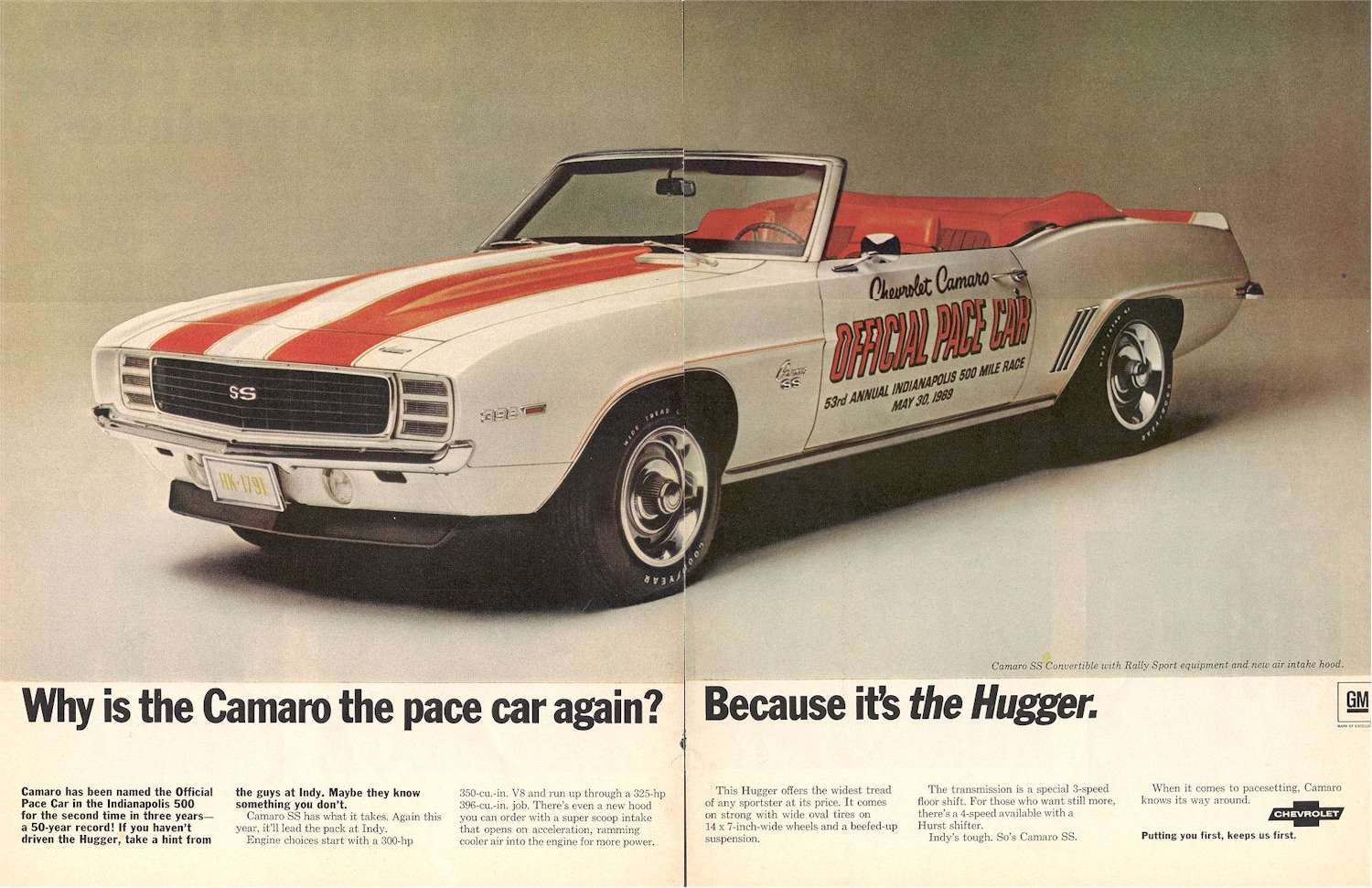
Z10!
It was a well kept secret for a number of years. The pace car
convertibles had a sibling!
There were a limited number of RS/SS coupes built via the option code Z10 that
received the pace car style orange Z28 striping, essentially coupe versions of the
pace car. Paperwork documenting why the cars were made has not been found, but they
were sold in the south, primarily in the southwest (Texas, Oklahoma, New Mexico, and
Arizona) and but also south central (Louisiana, Arkansas, and Tennessee). The option
was communicated to dealers in these states (probably via zone letters) and
the dealers then placed their orders (Chevrolet did not build cars without a dealer
or customer order). Production records have not been found. However, using CRG's data
on known Z10's, Z10 production is estimated to be between 450 to 500 cars.
Just under 200 cars are currently known.
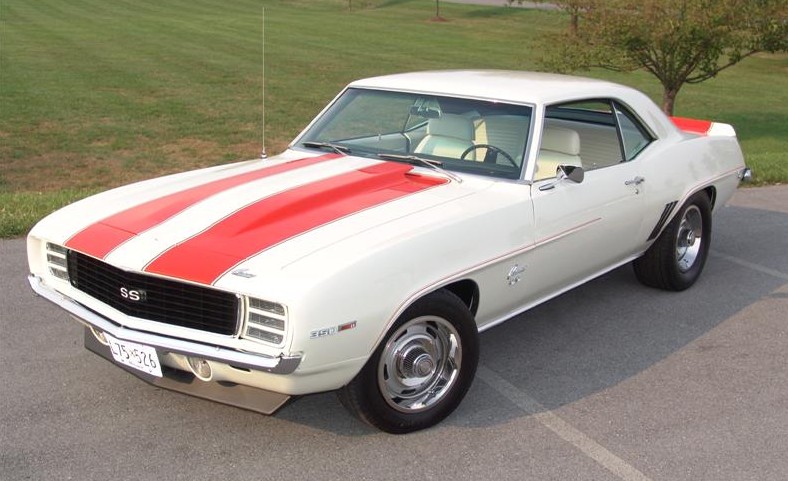
|
All Z10's are RS/SS's, painted Dover
white (code 50) with white rocker panels. SS396 cars
had white tailpanels. Required options for the Z10 package were
D80 spoilers, ZJ7 rally wheels, ZL2 special ducted hood, Z22 Rally Sport,
and Z27 Super Sport.
The Z10's were built at Norwood and Z10
was stamped on the cowl tag. All the cars were built between the
third week of April (04C) and the first week of May (05A). No Los
Angeles-built Z10's have ever been found and since LA was in the midst
of a strike when most Z10's were built, it's very doubtful any were made there.
Five different interiors have been observed in Z10's. Approximately 40% of
the Z10 cars received the ivory standard (code 727) interior. The other 60%
were relatively evenly split between four other interiors: black standard (711),
black deluxe (712), black houndstooth (713), and ivory houndstooth (729). No Z10's
have been found with the orange houndstooth (720) interior used in the pace cars.
Most Z10's have the L48 350/300 hp engine, but the 396 engines were optional.
Most of the cars that did have the 396 were equipped with the L35 325hp
engine, though there was at least one L78 396/375 hp Z10. The 3-speed manual
transmission was the base transmission, but, like most SS cars,
most Z10's were optioned with an automatic or a 4-speed manual.
About 40% of the known Z10's are manual and 60% are automatics.
Any other 69 Camaro option was available on the Z10.
A large percentage (about half) of Z10's have air conditioning and
several cars with vinyl tops have been found.
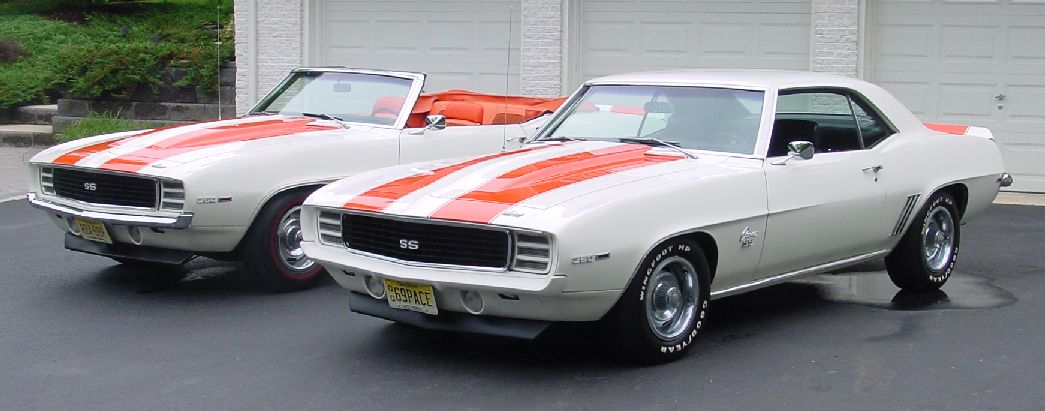
|
The Z10's were not at the 1969 Indy 500 race. Although they are sometimes
referred to as ‘pace car coupes’, neither the Indy 500 race nor the
pace cars are referenced in any known Z10 documentation. RPO Z10 is shown on the
window stickers as “Special Accent Striping” for $36.90; the
same price as the Z11 option. Door decals were not included with either Z10 or Z11 cars.
We do not know the reason for lack of reference to the Indy 500 in the known
Z10 material, but we can speculate. Perhaps it was to avoid the
Indy licensing fees, or perhaps there was a limitation in the
Indy contract that restricted replicas to be convertibles.
They definitely have a relationship to the pace cars, but until
documentation is found, it's all speculation as to why these
coupes were built and then distributed in such a limited area.
(As a side note: The Z10 RPO code was used over the years for other
special Chevrolet builds - e.g. the 1974 Spirit of America Nova, etc.)
You can help with the CRG's research on Z10's. If you own a Z10, please
contact the author
and include a picture of the trim tag. Thanks!
Footnotes
[1]
Note that the display vehicle at the pace car press conference is not believed
to be a pace car. The time is prior to the building of the first pace cars, it
does not have any engine emblems on the fenders, and it has black rocker panels.
It was probably a white car that was modified by Styling for prototype and
promotional purposes. This same car also shows up in a few early promotional pictures.
[2] The
Official Chevrolet Indy Pace Car Book by Crispino and Hooper.
[3] Norwood
was producing about 83% of 69 Camaros at the time (adjusting
for the early shut-down of the Van Nuys plant).
As a percentage of total production, Norwood produced 87% of all 69 Camaros.


